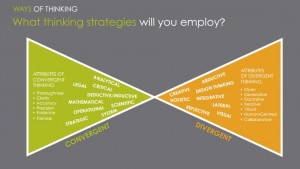It is estimated that the average person has upwards of 60,000 thoughts per day. That’s about 40 thoughts per minute. What’s spectacular about this number is the generating ability of the brain. What’s unfortunate is that the majority of these 60,000 thoughts are a) negative and b) concerning the past and/or future. If we consider ourselves to be governed by our thoughts, what does our thought process say about ourselves? What if we were more aware of our thoughts, consciously filtered out the clutter, questioned why we think certain ways, wouldn’t you say we ourselves had the power to be more productive? Efficient? Successful? Happier?
Given that our thoughts largely dictate our moods, behaviour, and actions, it is important to understand our thinking process. And this is exactly what I’ll be doing over the next 4 months as a student in Comm 388: Sauder d.studio. The core of this class is built around “design thinking”. We are introduced to unique strategic thinking processes that utilize both sides of the brain: not only our logic and intuition, but also our creativity and imagination. These processes will ultimately help us become effective problem solvers and create innovative business solutions for today’s changing world.
But what does “design thinking” actually mean? I will attempt to sum that term up later, but first I will reflect on my own thinking process.
Thinking about thinking… that definitely hurts my brain. But after consciously observing my thoughts for a couple hours on the bus, I was able to come up with a list of words and subsequent questions that I feel characterize my thinking process. Comparing these adjectives, one of the ways they can be grouped are by Daniel H. Pink’s “Six Senses” Framework. He refers to these 6 components as R-sided aptitudes that we need to embrace in addition to L-sided aptitudes. They are: Design, Story, Symphony, Empathy, Play and Meaning. I’ve attempted to sort the traits below into these 6 areas.
Personal: “How does this benefit me/how can I uniquely contribute?” S
Futuristic: “What are the long term effects?” M
Communal: “How does this affect my friends, neighbors, people in other countries?” E
Big picture: “How relevant is this in the grand scheme of things?” M
Divergent: “What connections do I see between seemingly different things?” Sy
Needs vs. wants: “Is this necessary!?” D
Realistic: “Would this be feasible in the real world?” D
Proactive: “What can I do about it now?”
Reflective: “Why did this happen and what were the causes?” M
Positive: “What’s the best case scenario?” P
Developmental: “How can we improve this?” D
Logical: “What makes sense?”
Multi-disciplinary: “How can I balance creativity and logic?” Sy
Given these traits, the struggle for me is finding the right balance of each and when it is most appropriate to use. Because I tend to want to apply more than 1 thinking process at a time, the result is analysis paralysis: I’ll want to tackle a problem from all angles, only to get anything done! As my classmate Eric Seto quoted in his reflection blog: “Design thinking is more than just thinking, you can’t have design without doing”. What I look forward to practicing in Comm 388 is identifying what my thinking process strengths are, applying the right combination of these thinking strategies, and understanding the benefits/drawbacks of each by working in teams.
Now that I am more aware of the way I think, what does “design thinking” mean to me?
To me, design thinking means finding a solution through artistic, creative means. Like described in the video, this process is visual, collaborative, active, expansive, and hands on. Just as an artist makes sketches before painting the final canvas, it takes trial and error to arrive at an end conclusion, as does it take days of pondering to make a hard decision. In this way, design thinking may be the key to exploring and solving future world problems that may not yet exist.
All this thinking has made my sleeping, so I will mind my mind and let it rest. After all, 60,000 thoughts is a lot of work!
-M
